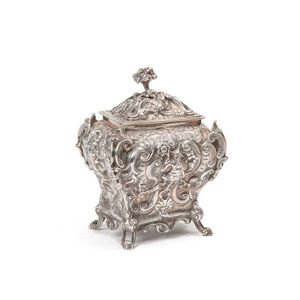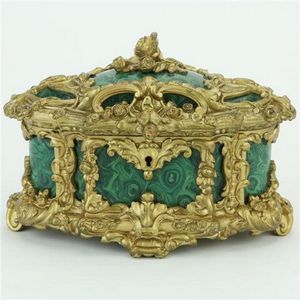Gilded Yixing Tureen with Elephant Handles
Lidded tureen of unknown material and origin, possibly Yixing stoneware, modelled with gilded rope twists, chrysanthemum flower petals, elephant head handles and raised on four feet, the inside of the lid and base has been lacquered in black. Small chips and expected signs of use. Height 22 cm. Length 27 cm
You must be a subscriber, and be logged in to view price and dealer details.
Subscribe Now to view actual auction price for this item
When you subscribe, you have the option of setting the currency in which to display prices to $Au, $US, $NZ or Stg.
This item has been sold, and the description, image and price are for reference purposes only.
- Gilding - Gilding is a method of ornamentation whereby a thin sheet of gold metal is applied to items made of wood, leather, ceramics, glass and silver for decorative purposes.
For furniture including mirrors, the sheet of gold is usually applied over a coating of gesso. Gesso is a mixture of plaster of Paris and gypsum mixed with water and then applied to the carved wooden frames of mirrors and picture frames as a base for applying the gold leaf. After numerous coats of gesso have been applied, allowed to dry and then sanded a coat of "bole", a usually red coloured mixture of clay and glue is brushed on and allowed to dry, after which the gold leaf is applied. Over time parts of the gilding will rub off so the base colour can be seen. In water gilding, this was generally a blue colour, while in oil gilding, the under layer was often yellow. In Victorian times, gilders frequently used red as a pigment beneath the gold leaf.
Metal was often gilded by a process known as fire gilding. Gold mixed with mercury was applied and heated, causing the mercury to evaporate, the long-term effect of which was to kill or disable the craftsman or woman from mercury poisoning. The pursuit of beauty has claimed many victims, not the least of which were the artists who made those pieces so highly sought after today.
This item has been included into following indexes:
Visually similar items

A George IV sterling silver Chinoiserie tea caddy by John Wintle, London circa 1825, 17 cm high, 585 grams
Sold by
in
for
You can display prices in $Au, $US, $NZ or Stg.

A 20th century Maori lidded kumete (food bowl) c.1950s. Length 45 cm.
Sold by
in
for
You can display prices in $Au, $US, $NZ or Stg.

Ormolu jewellery casket with ornate designs framing marble patterned windows & a velvet lined interior, 18 x 13 x 10 cm.
Sold by
in
for
You can display prices in $Au, $US, $NZ or Stg.

A pair of Neo-Classical reconstituted stone urns
Sold by
in
for
You can display prices in $Au, $US, $NZ or Stg.
